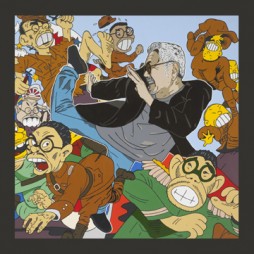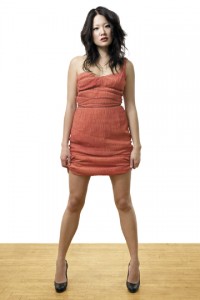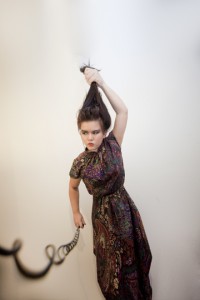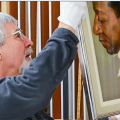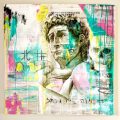Beyond the stereotypes: “Asian American Portraits of Encounter”
(Image: Detail from “Shimomura Crossing the Delaware” by Roger Shimomura. 2010. Collection of the artist, © Roger Shimomura.)
The Smithsonian’s National Portrait Gallery and the Smithsonian Asian Pacific American Program have collaborated to mount the Smithsonian’s first major showcase of contemporary Asian American portraiture. Through the work of seven artists from across the country and around the world, the exhibition offers provocative interpretations of the Asian American experience and representations against and beyond the stereotypes that have obscured the complexity of being Asian in America. “Portraiture Now: Asian American Portraits of Encounter” opens Aug. 12 and will be on view through Oct. 14, 2012.
This group of artists represents a diverse cross-section of Asian American experiences and demonstrates, in microcosm, the nuances inherent to the Asian American experience.
Roger Shimomura (b. 1939) is a third-generation American of Japanese descent who has spent his career fighting stereotypes through his art. Shimomura has focused particular attention on the experiences of Asian Americans and the challenges of being “different” in America. He knows well the pain and embarrassment associated with xenophobia.
“I was born and raised in Seattle, Washington, a city where ethnic diversity is standard fare; however, for the last forty years, I have lived in the Midwest, where the Asian American presence is still somewhat of a rarity,” Shimomura says.
“Since living in Kansas, I have found it to be routine to be asked what part of Japan I am from, or how long I have lived in this country. Just as common, subtle references continue to connect me to stereotypical ‘oriental’ traits, both physical and behavioral. Far too many American-born citizens of Asian descent continue to be thought of as only ‘American knockoffs.’”
Shizu Saldamando (b. 1978) was born in San Francisco to parents of Japanese and Mexican descent and lives today in Los Angeles. “Growing up in the Mission district in San Francisco, it was predominately a hip-hop culture,” Saldamando explains. “Here in Los Angeles, I’d go to shows or house parties, and it would be all Latino kids listening to the Cure and the Smiths. In L.A., I felt normal for the first time.” Saldamando’s meticulous collaged paintings offer the viewer a subtlety of influences to ponder.
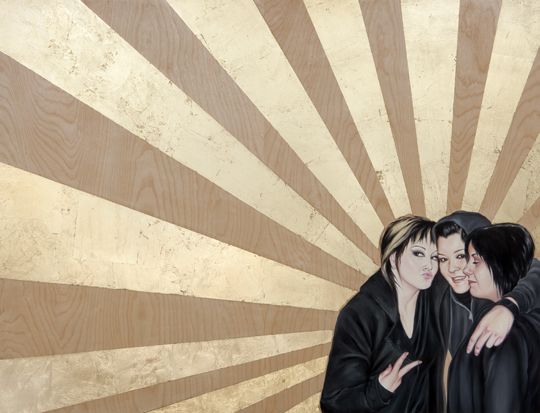
"Carm's Crew" by Shizu Saldamando, 2009, Jo Willems and Karen O'Brien © Shizu Saldamando. Photograph by Michael Underwood.
Other artists use concepts of diaspora, migration and transnationalism to expand the meaning of their Asian American identity. Some are artists from Asia who work in the U.S., like Satomi Shirai (b. 1972), who moved to New York from Japan, and Hye Yeon Nam (b. 1979), who came to the U.S. from Korea to study art. The title of Satomi Shirai’s photographic project, Home and Home: New York in My Life, indicates a coming-to-grips with the dislocations caused by her move to the city from Japan in 2004.
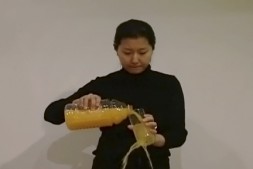
Still from "Drinking (Self-Portrait)" by Hye Yeon Nam, single channel video, running time 03:44 minutes, 2006. Collection of the artist © Hye Yeon Nam
Keenly aware of distinctions in expectations for the appropriate behavior for women in her native land and the United States, Nam has created a body of work that addresses feelings of awkwardness with subtlety and humor. Her four-part video self-portrait—Walking, Drinking, Eating, and Sitting—transforms everyday activities into sites of confusion. A hole in a glass continually spills orange juice. Nam provides a reminder that “fitting in” requires consistent negotiation between the self and perceived expectations—a challenge to which we can all relate.
Zhang Chun Hong (b. 1971) has spent the past year in her native China, but makes her home in Lawrence, Kan. Artists such as CYJO (b. 1974) travel back and forth from Asia to America; her Kyopo Project focuses on the international community of Koreans born and living abroad. Tam Tran’s (b. 1986) family relocated to Memphis, Tenn., from Vietnam during the early 1990s.
“The ‘Portraiture Now’ exhibition series showcases innovative trends in portraiture,” said Martin Sullivan, director of the National Portrait Gallery. “‘Portraiture Now: Asian American Portraits of Encounter,’ is a provocative and pathbreaking show that affirms the complex realities of Asian identity in today’s culture.”
“These exceptional works are portals into the souls of the American experience, world cultures and their intersections,” said Konrad Ng, director of the Smithsonian Asian Pacific American Program. “‘Asian American Portraits of Encounter’ provides engaging points of view that will enrich the understanding of Asian Pacific America.”
The National Portrait Gallery curators for this exhibition are Brandon Brame Fortune, Anne Collins Goodyear, Frank H. Goodyear III, Lauren Johnson, Rebecca Kasemeyer, Wendy Wick Reaves, Ann M. Shumard and David C. Ward.
Posted: 1 August 2011
- Categories:

